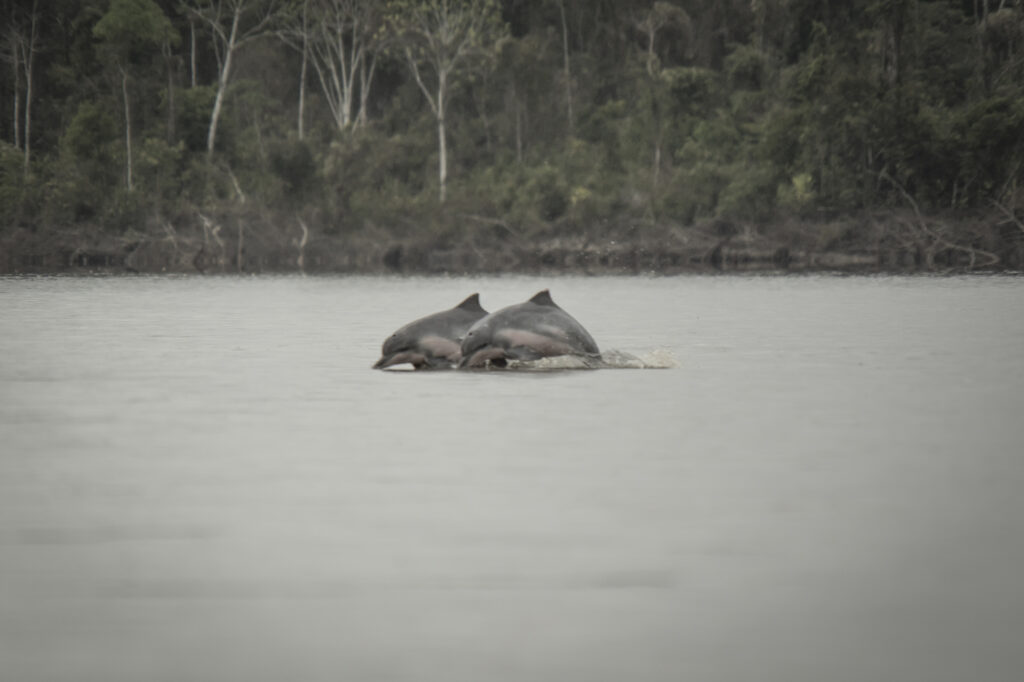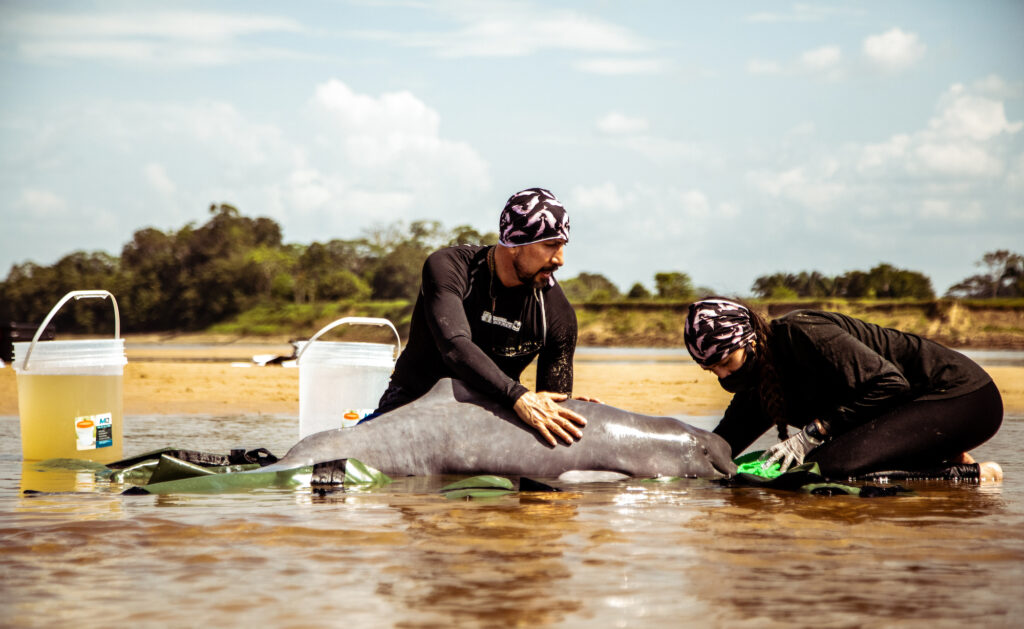Key upshots:
- The total number of river dolphin species decreased by 73% during the 1980s.
- The six surviving species of this aquatic mammal that live in the world’s rivers and are threatened are expected to be protected by a coalition of 14 countries, six of which are in Latin America, under the Global Declaration for River Dolphins. Nine of the participating governments have signed the declaration thus far.
- The announcement comes at a crucial time for these creatures. Concern was expressed worldwide in September 2023 after over 150 river dolphins in one of Brazil’s most significant lakes perished.
Actually, 154 endangered Amazon river dolphins were discovered dead in Brazil’s Lake Tefé last September during a particularly severe drought. For those who advocate for the conservation of threatened freshwater cetaceans, this served as a sobering reminder of the need for immediate action.
Daphne Willems expressed concerns, “For us, this is a crisis. In one month, more than 10% of the populations of the two dolphin species that inhabit Lake Tefé died.”
She added, “We’ve never seen this before. It’s climate change. The water was significantly reduced and temperatures rose to 40° Celsius (104° Fahrenheit). Dolphins are not generally sensitive to temperatures; it doesn’t bother them much. But this was like cooking them.”
Only a few weeks before October 24, International River Dolphin Day, there was an extensive death. Important figures for the species convened in Bogotá, Colombia, to mark this day. Participants in the meeting talked about success stories, a continental work session, and the political context around dolphins.

Encouraging countries to sign the Global Declaration for River Dolphins was the primary goal of the summit, which was organized by the Colombian government in collaboration with WWF, the Omacha Foundation, the World Bank, and experts from the South American River Dolphin Initiative (SARDI).
Many Nations Nod Sought While Some Pending:
Fourteen of the nations that make up the animal’s range—Bangladesh, Bolivia, Brazil, Cambodia, China, Colombia, Ecuador, India, Indonesia, Myanmar, Nepal, Pakistan, Peru, and Venezuela—have agreed to boost regional and national initiatives and put concrete plans into action as a result of the declaration.
Nine of these nations have ratified the statement thus far. Pakistan, Peru, China, Indonesia, and Myanmar are still pending.
The proclamation, according to WWF, aims to stop and reverse the decline of all river dolphin populations, establish a network of carefully monitored and protected river habitats, and encourage studies on these marine mammals. Among other things, it asks for ending unsustainable fishing methods and working with Indigenous people and local communities.
As per the declaration, “The crisis facing river dolphin populations has not yet reached the international attention it deserves. Saving these species is a mutual responsibility that also benefits rivers and wetlands.”
Rivers Home To Dolphins:
Many of the biggest rivers in Asia and South America, including the Amazon, Irrawaddy, Ganga, Indus, Mahakam, Mekong, Orinoco, and Yangtze, are home to river dolphins. On their banks, nearly a billion people come together.
Concerned about the widespread fatalities of dolphins in Brazil, WWF notes in a letter that human populations are also impacted by the climate changes observed in the Amazon River’s tributaries. Along these rivers are several isolated settlements.
“It is estimated that almost half a million people are affected in the region, with a state of emergency declared in 55 of the 62 municipalities in the Brazilian state of Amazonas alone,”
Due to low water levels, numerous rivers are already impassable, which poses a risk to water supplies and makes it difficult to convey food and medicine.
Experts believe that the crisis in Brazil demonstrates how unprepared countries are for the effects of climate change.
We have Trujillo, who is a notable biologist and has a towering mastery of river dolphins and is also a scientific director at Omacha Foundation, an organization that has spent more than 30 years keeping an eye on Colombia’s wildlife as well as the Amazon and Orinoco rivers and their tributaries.
According to Trujillo, the major theory of what happened in Lake Tefé is that the scorching temperatures led algae to generate a toxin capable of harming the central nervous system of numerous animals, including dolphins. However, studies are still ongoing at the Mamirauá Institute in Brazil.
Mr Trujillo opines, “At the moment, in Brazil, physical barriers have been built with logs to prevent dolphins from accessing shallow areas where this alga is releasing the toxin.”
He continued, “This happened in Lake Tefé in Brazil, but it can happen at any time and
Why do dolphins have significance?
River dolphins, who are regarded as top predators in several of the world’s major river systems, are essential to preserving ecological equilibrium. They are canaries for the environment:
Dolphins are a good indicator of the health of the river and its fish numbers, as well as many other wildlife species, towns, and industries that depend on the river.
“Dolphins play a fundamental role in the ecosystems they inhabit: They are indicators of the ecosystem’s health. Other species and people can therefore live and depend upon them in healthy rivers,” describes Tarsicio Granizo, director of WWF Ecuador.

6 Species Of River Dolphins:
The Indo-Pacific finless porpoise (Neophocaena phocaenoides), the only freshwater porpoise in the world, the Amazon river dolphin (Inia geoffrensis), the Ganges river dolphin (Platanista gangetica), the Indus river dolphin (Platanista minor), the Irrawaddy dolphin (Orcaella brevirostris), and the tucuxi (Sotalia fluviatilis) are the six species of river dolphins.
The Yangtze finless porpoise (N. asiaeorientalis) is sometimes classified as belonging to its species and other times as a member of the Indo-Pacific finless porpoise.
anywhere in the Amazon.
Current Species Confront Harsh Realities:
The challenges to the existing species include irresponsible fishing and trawling, pollution, illegal mining, direct hunting, and the development of infrastructure.
The results have been disastrous. The total number of river dolphin populations has decreased by over three-quarters (73%) during the 1980s.
Willems comes explaining again, “In Asia, we have two endangered species and two that are critically endangered. In Colombia and the rest of the Amazon, the situation is the same:
We don’t know how many individuals there are, but we know that the trend is negative.”
He made the addition, “We have fewer dolphins now than we did a decade ago. … This is why it’s so important for countries to work together because the threats and conditions are often very similar.”
Campbell terms the recent declaration as “an excellent initiative.
She maintains, “What has happened is that each country has different objectives, policies and conservation areas, but dolphins aren’t assigned to a certain country or area — they move.”
“That’s why it’s better that countries are aligned and all have the same protection.”
The fight to protect dolphins
There is hope that the demise of certain river dolphin species can be stopped thanks to global efforts.
For instance, the Yangtze finless porpoise, a critically endangered species, had declined for decades in China, and the results of the most recent census showed that the reduction was permanent.
WWF claims, it “showed a 23 per cent increase in the population in the past five years.”
“The first increase since records began. This is the result of strict protection measures and conservation efforts. Despite this, only 1,249 Indo-Pacific finless porpoises remain.”
The baiji disappeared from this same river system.
Signalling devices have increased fish catches for local populations in Indonesia while also successfully preventing dolphins from drowning in fishing nets.
In the meantime, over the previous 20 years, the number of dolphins living in the Indus River has nearly doubled in Pakistan and India. But there are just about two thousand people.
Willems laments, “Governments can’t do much by themselves. In the global declaration, several institutions and organisations are working on monitoring and raising awareness. There are also private sector actors that support projects, as well as international conventions and many foundations that help.”
“At the end of the day, this is key.”
Willems goes on to say that local communities are crucial players “because they have the information and the connections.” She said that to make things better, everyone needed to cooperate.
“Communities are the eyes and ears of the rivers — they live with the species,”
Trujillo claims that the global declaration is the culmination of the efforts of civil society organizations, who with limited funding developed a foundation of knowledge and recommendations that, one hopes, will become public policy.
“Dolphins are now being seen as a magnifying glass that we can apply in certain geological areas — in South American and Asian rivers — to try and do positive things for these ecosystems. Ten years ago, no one knew about river dolphins. Now, people are understanding that through their conservation we can open a window of opportunity for these great rivers in the world, to be able to conserve them and improve the quality of life of the people who live around them,” contributes Trujillo.






2 Comments
I loved even more than you could possibly be able to accomplish right here. The picture is beautiful, and your language is elegant; yet, it appears that you are rushing through it, and I believe that you ought to give it another shot in the near future. That is something that I will most likely do again and again if you protect this hike.
Pingback: India Joins 9 Nations With A Pledge To Protect ...